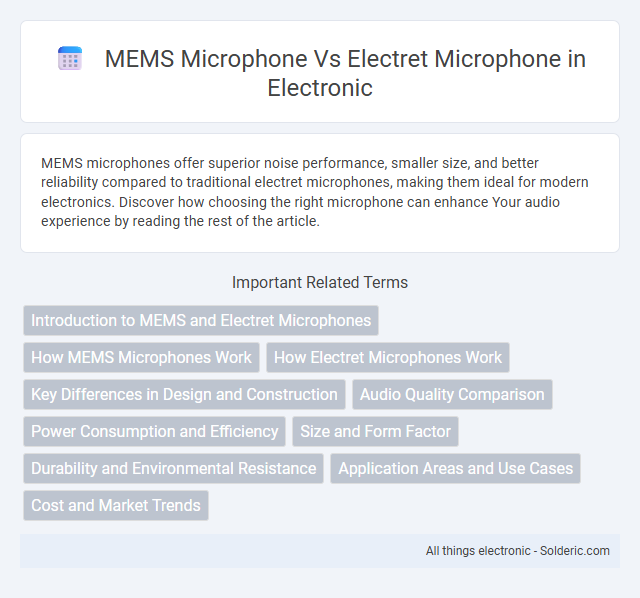MEMS microphones offer superior noise performance, smaller size, and better reliability compared to traditional electret microphones, making them ideal for modern electronics. Discover how choosing the right microphone can enhance Your audio experience by reading the rest of the article.
Comparison Table
| Feature | MEMS Microphone | Electret Microphone |
|---|---|---|
| Technology | Micro-Electro-Mechanical Systems | Electret Condenser |
| Size | Very Small (2-4 mm) | Larger (5-10 mm) |
| Power Consumption | Low Power Consumption | Moderate Power Consumption |
| Frequency Response | Wide and Flat Frequency Response (20 Hz - 20 kHz) | Good Frequency Response (30 Hz - 15 kHz) |
| Sensitivity | High Sensitivity (-38 to -42 dBV/Pa) | Moderate Sensitivity (-40 to -44 dBV/Pa) |
| Signal-to-Noise Ratio (SNR) | High SNR (up to 65 dB) | Lower SNR (around 55 dB) |
| Durability | Robust, Resistant to Environmental Factors | Less Durable, Sensitive to Humidity |
| Cost | Higher Cost | Lower Cost |
| Applications | Smartphones, Wearables, IoT, High-Quality Audio | Telephones, Hearing Aids, Basic Audio Devices |
Introduction to MEMS and Electret Microphones
MEMS microphones utilize microelectromechanical systems technology to convert sound into electrical signals with high sensitivity and a compact design, making them ideal for modern smartphones and wearable devices. Electret microphones rely on a permanently charged dielectric material to detect sound vibrations, offering reliable performance and cost-effectiveness in traditional audio applications. Understanding the differences in size, sensitivity, and integration helps you choose the right microphone for your specific audio project.
How MEMS Microphones Work
MEMS microphones operate by converting sound waves into electrical signals using a microelectromechanical system consisting of a diaphragm and a fixed backplate that form a variable capacitor. When sound pressure causes the diaphragm to move, the capacitance changes, generating an electrical signal proportional to the acoustic input. Your choice of a MEMS microphone ensures improved sensitivity, smaller size, and better resistance to environmental factors compared to electret microphones.
How Electret Microphones Work
Electret microphones operate using a permanently charged dielectric material that forms a stable electrostatic field, allowing them to convert sound waves into electrical signals without an external power source. Their design includes a diaphragm attached to an electret film, which vibrates in response to sound pressure, causing variations in capacitance that generate an audio signal. Your choice between MEMS and electret microphones depends on factors like size, sensitivity, and power consumption, with electret models commonly favored for their simplicity and low cost.
Key Differences in Design and Construction
MEMS microphones use microelectromechanical systems technology, featuring a silicon-based diaphragm and capacitor within a compact chip, enabling precise sound detection and miniaturization. Electret microphones employ a permanently charged polymer film diaphragm coupled with an FET preamplifier, housed typically in a metal or plastic casing. The MEMS design offers greater integration with digital circuits and enhanced durability compared to the bulkier, more analog-focused construction of electret microphones.
Audio Quality Comparison
MEMS microphones offer superior audio quality compared to electret microphones due to their higher signal-to-noise ratio and improved sensitivity, resulting in clearer and more accurate sound reproduction. Their advanced fabrication process enables consistent performance and better resistance to environmental factors such as humidity and temperature fluctuations. If you're seeking reliable, high-fidelity audio capture, MEMS technology is often the preferred choice over traditional electret microphones.
Power Consumption and Efficiency
MEMS microphones typically consume less power than electret microphones, making them more suitable for battery-operated and energy-efficient devices. Their integrated transistor design enhances efficiency by reducing signal noise and improving sensitivity at lower voltage levels. Your choice of microphone impacts overall device power management, with MEMS providing longer battery life and better performance in compact electronics.
Size and Form Factor
MEMS microphones boast a significantly smaller size and compact form factor compared to electret microphones, making them ideal for integration into modern portable devices. Their miniature dimensions, often just a few millimeters, allow designers to save valuable space on your device's circuit board. Electret microphones, on the other hand, tend to be bulkier with fixed shapes, limiting flexibility in design and placement.
Durability and Environmental Resistance
MEMS microphones offer superior durability and environmental resistance compared to electret microphones due to their solid-state construction and robust packaging. Their ability to withstand extreme temperatures, humidity, and mechanical shock makes them ideal for harsh environments and long-term applications. Electret microphones, while cost-effective, typically exhibit reduced lifespan and sensitivity degradation when exposed to moisture and dust.
Application Areas and Use Cases
MEMS microphones excel in compact consumer electronics, including smartphones, hearing aids, and IoT devices, due to their small size, low power consumption, and high reliability. Electret microphones are widely used in telecommunication devices, voice recorders, and PA systems because of their cost-effectiveness and stable performance in varied acoustic environments. Both types support voice recognition systems, but MEMS microphones are preferred in advanced applications requiring digital integration and environmental noise immunity.
Cost and Market Trends
MEMS microphones typically offer lower production costs due to advanced semiconductor fabrication techniques, making them increasingly preferred in mass-market consumer electronics. Electret microphones, while historically dominant for their affordability and simplicity, face declining market demand as MEMS technology provides better scalability and integration capabilities. You can expect MEMS microphones to continue gaining market share, driven by cost reductions and widespread adoption in smartphones, wearables, and IoT devices.
MEMS microphone vs electret microphone Infographic

 solderic.com
solderic.com